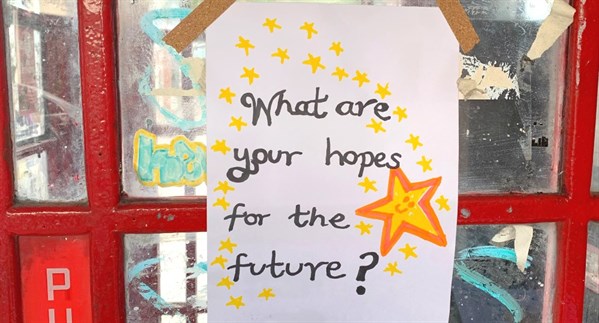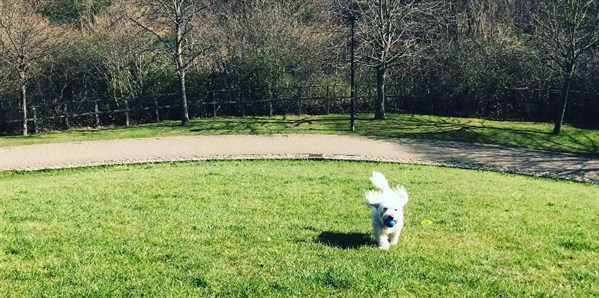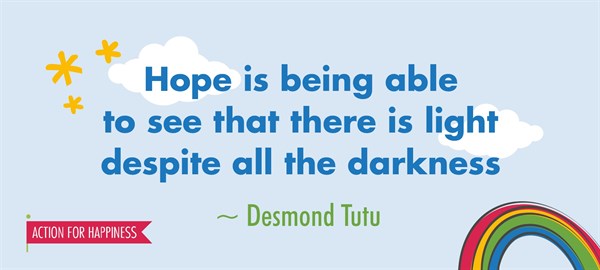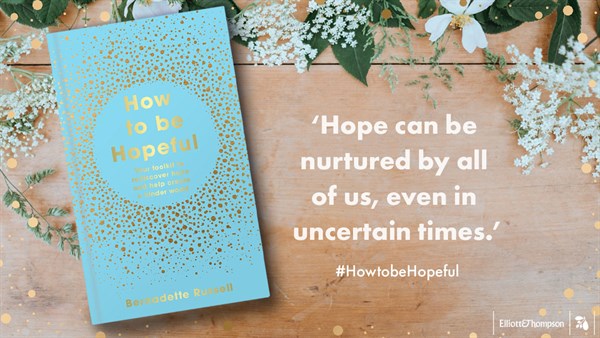How To Be Hopeful
09 Sep 2020 | Bernadette Russell
"Normal day, let me be aware of the treasure you
are" ~ Mary Jean Irion

One morning a few years ago, I took my dog Lola for a walk
around the docklands close to where I live. It was cold enough to
make miniature clouds of my breath. The trees were fancily dressed
in their October best: a rich display of burgundy, mustard and
rust, with the sky a forget-me-not blue.
I sat on a bench for a while and watched a flock of geese fly in
an arrow over the woods. A man threw a stick for his dog nearby and
shouted out, 'Oi! Fetch that, Gizmo!' which made me laugh. The man
waved at me and I waved back. On the path beside me, written in
childlike handwriting with pink chalk, were the words 'Hello
everyone here' plus a smiley face.
It was an ordinary day. It was also utterly, heartachingly
beautiful. I thought about the world, and how many countless other
incredible places and inspiring people there are, how much there is
all around us to generate awe and wonder. There is lots to be
excited and joyful about, there is plenty of fun to be had, I
thought. I was so grateful to be alive in that moment. I felt
extremely lucky, and I enjoyed that feeling. I walked home and
thought about how important it was to take time to notice all the
good stuff.

Of course, it's not always possible or easy for us to find the
joy in our 'ordinary days'. As adults, most of us have many
responsibilities and sometimes they can make finding pleasure in
the moment a bit of a struggle. We have to work, look after our
families, manage our finances, all that hum-drum day-to-day stuff,
before we even begin to consider the bigger picture of the wider
world and all its opportunities and challenges. Our jobs,
relationships, all the choices we make as we journey through life
can be boring as well as exciting, stressful as well as
relaxing.
There's no doubt that it can be hard to maintain hope in the
midst of the daily grind: when you're squashed onto a train in rush
hour crushed up against a stranger's arm-pit, scrolling through
pictures of other people on holiday in Lanzarote; when you get the
fourth gently patronising rejection in a week for a job you didn't
really want anyway; when the bus doesn't stop because the driver
didn't see you; when your feet get wet because the roads are full
of potholes and you can't afford new trainers; when you're not sure
where the money you need for this month is going to come from. And
we can sometimes criticise ourselves very harshly when we're
feeling run down.
So, it's important that we look at how we might navigate the
everyday, 'ordinary' challenges and make hope a part of our daily
lives, before we move on to the bigger trials all humans face -
such as anxiety, loss and grief - and how we create hope there.

What can be really helpful in getting through life's little
challenges is to identify the specific things that give you a boost
of hope. If we can pay attention to what helps us to foster a more
resilient and positive attitude in our day-to-day, this can become
a kind of bedrock to help to keep us hopeful, whatever comes our
way. One thing that really helps me is allowing myself to
appreciate the beauty in the world around us, at every
opportunity.

Try This: EVERYDAY BEAUTY
Make a habit of noticing one beautiful thing every day. This can
be as simple as the reflection of streetlights in puddles, an
architectural feature of a building you pass frequently, a loved
one's smile or laughter, dogs playing in the park.
Once you've noticed it, allow yourself a few moments to enjoy
it. I find that these short periods of appreciation and reflection
make me feel more hopeful about what's good in the world,
especially when I felt a bit overwhelmed. If we can focus on the
everyday beauty all around us, if only for a short time, it can
give us a breath of respite - a moment of pause to allow our minds
to take a step back.
A good way to begin thinking about hope in your everyday is
simply by spending some dedicated time considering the things that
you find inspiring, that cheer you and put a smile on your face.
The more aware you are of what brings you joy, the easier it will
be to know what to do when you need a bit of a pick-me-up.
If you find it tough to get started, that's okay. I sometimes
imagine hope as a single candle in a massive pitch-black cave -
it's not going to show us the whole cave, but it will highlight a
few glimmers of detail, enough to help ground us and keep fear at
bay. We're not looking for any big 'solutions' in this chapter:
hope can be found in the smallest of things. It could simply be the
neighbour who looks after an elderly friend, a warm welcome and a
cup of tea in your local community centre, or the nettles in your
garden covered in caterpillars (because not weeding is a win for
both you and nature).
I have listed a few of my hopeful things here, some found closer
to home, some further afield. Yours might be completely different:
scientific and technological innovations, people, places, works of
art, whatever takes your fancy. I've written down what gives me
hope, but also why, because it can make our connection to that
thing much stronger and help us figure out what hope looks and
feels like to each of us as individuals.
- What: The pianos that are left on the
concourse at train stations, free for anyone to play.
- Why: People have the chance to play and to
share their love of music. They give some space and time for
strangers to come together and enjoy something beautiful for
free.
- What: Children planting edible playgrounds in
their primary schools.
- Why: Kids have the chance to become more
connected to nature and will cherish and protect it better than we
have done. They will know how to grow their food.
- What: The ex-poacher turned wildlife protector
I read about in South Africa.
- Why: Human beings can have the courage and
humility to change their minds and their lives. Other people will
support their change, and still more people will see that happen
and be encouraged by it.
- What: That nobody knows with absolute
certainty what the future holds.
- Why: It could be wonderful.

Try This: MAKE A HOPE COLLECTION
I found it really useful to gather the things that make me
hopeful together in a scrapbook - what I call my hope collection.
This way, they can't simply slip away and be forgotten or pushed
out by the day-to-day cares we all experience. You may be the kind
of person who prefers drawing or taking pictures, doodling or even
making audio recordings. We're all different. I'd recommend putting
a notebook in your bag or putting a stack of paper and a pen next
to your bed, so you can add to it whenever inspiration strikes. I
add to my collection a couple of times a week.
Try not to edit yourself or make harsh judgements about your
choices - whatever gives you hope is the right thing, and nobody
need see them but you. Your hope collection is there for you
whenever you need it, to remind you that there is a lot about which
to be hopeful.
Allowing yourself to experience hope is a powerful form of
self-care, providing you with the courage and strength to carry on,
to reach for a brighter future, even on the cloudiest of days.

Bernadette's latest book How To Be Hopeful: Your Toolkit to Rediscover Hope
and Help Create a Kinder World is published by Elliott &
Thompson.